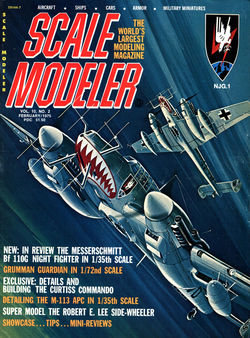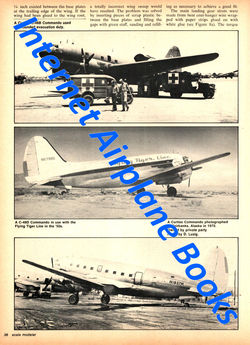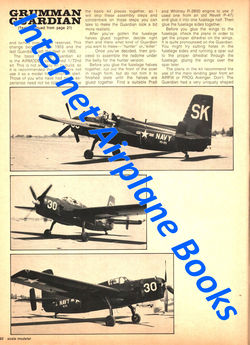SCALE MODELER FEB 75 WW2
LUFTWAFFE Bf-110G NJG_GRUMMAN GUARDIAN USN_VIETNAM M113_C-46 USAAF
SINGLE ISSUE OF VINTAGE MODELLING MAGAZINE
WW2 GERMAN LUFTWAFFE MESSERSCHMITT Bf-110G NIGHTFIGHTER
NJG NACHTSJAGER
US NAVY GRUMMAN AF GUARDIAN VS SUBMARINE HUNTER-KILLER
CURTISS C-46 COMMANDO
VIETNAM WAR US ARMY M113 ARMOURED
PERSONNEL CARRIER APC
THE SIDEWHEELER ROBERT E. LEE
PAYSTAR DUMP TRUCK
SOLDIERS OF ROME
-----------------------------------------------------------------------------------------------
Additional Information from Internet
Encyclopedia
The Bf
110's main strength was its ability to accept unusually powerful air-to-air
weaponry. Early versions had four 7.92 mm (.312 in) MG 17 machine
guns in the upper nose and two 20 mm MG FF/M cannons fitted in the lower
part of the nose. Later versions replaced the MG FF/M with the more powerful
20 mm MG 151/20 cannons and many G-series aircraft, especially those which
served in the bomber-destroyer role, had two 30 mm (1.18 in) MK 108
cannons fitted instead of the MG 17. The defensive armament consisted of a
single, flexibly mounted 7.92 mm (.312 in) MG 15 machine gun. Late
F-series and prototype G-series were upgraded to a 7.92 mm (.312 in)
MG 81 machine gun with a higher rate of fire and the G-series was equipped with
the twin-barreled MG 81Z. Many G-series night fighters were retrofitted or
factory-built with the Schräge Musik
off-bore gun system, firing upward at an oblique angle for shooting down bombers
while passing underneath, frequently equipped with two 20 mm MG FF/M, but
field installations of the 20 mm MG 151/20 or 30 mm (1.18 in) MK
108 cannons were also utilized. The Schräge
Musik weapons were typically mounted to the back of the rear cockpit.
The Bf
110 G-2/R1 was also capable of accepting armament such as the Bordkanone series 37 mm
(1.46 in) BK 3,7 autofed cannon, mounted in a conformal ventral gun pod
under the fuselage. A single hit from this weapon was enough to destroy any
Allied bomber.
The
fighter-bomber versions could carry up to 2,000 kg (4,410 lb) of
bombs, depending on the type.
Bf 110G-4: Three-crew night fighter,
FuG 202/220 Lichtenstein radar, optional Schräge
Musik, usually mounted midway down the cockpit with the cannon muzzles
barely protruding above the canopy glazing
---------------------------------------------------------------------------------------------
The Grumman AF Guardian was the first
purpose-built anti-submarine warfare (ASW) carrier-based aircraft to enter
service with the United States Navy.[1] It consisted of two airframes, one for
detection gear, the other for weapons. The Guardian remained in service until August
1955, when it was replaced by the twin-engined Grumman S-2 Tracker. The
Guardian was the largest single-engine piston-powered carrier aircraft ever to
see service.
The original design concept for the
aircraft that would become the Guardian, the XTB2F of 1944, was for a
twin-engined aircraft with a 3,600 lb (1,600 kg) warload and a range of 3,700
mi (5,950 km).[3] This was considered to be too large for practical use from an
Essex-class aircraft carrier, and was cancelled in 1945, replaced by a modified
Grumman F7F Tigercat, the XTSF-1.
However, this too was considered
impractical,[5] and another alternative, the internally developed Grumman Model
G-70, was selected instead, being given the Navy designation XTB3F-1. This was
designed as mixed-power aircraft, with a Pratt & Whitney Double Wasp radial
engine in the nose and a Westinghouse 19XB turbojet in the tail.[4] Originally,
the Westinghouse engine was to be the new X24C which was to emerge as the J34
series. When it became apparent the X24C delivery schedules would not meet the
airframe schedule, the 19XB-2B was substituted. This was found to be
unsuitable, and the jet engine was removed without ever having been used in
flight.[4] The XTB3F-1S carried a crew of two seated side-by-side and an armament
of two 20 mm cannon and 4,000 lb (1,814 kg) of bombs, torpedoes and/or rockets,
and made its first flight on 19 December 1945.
On 24 December 1945, the Navy changed
the role of the aircraft from torpedo-bomber to anti-submarine warfare. All the
required equipment could not be fitted into a single aircraft, consequently two
variants would be produced, one as a "guppy" (hunter) and another as
a "scrapper" (killer).[6] The hunter aircraft would not carry any
armament,[2] but instead two additional crew members and a ventral radome for
APS-20 search "eyes" (radar) and Electronic Countermeasures (ECM)
"ears", consisting of an APR-98 Countermeasures Receiver and AP-70
Bearing Indicator.[7] This aircraft, the XTB3F-1S, first flew in November
1948.[4] The "killer" deleted the cannon of the torpedo bomber, but
retained the bomb bay, added a third crewmember, a searchlight, and short-range
radar, and (as the XTB3F-2S) first flew in January 1949.
Redesignated as AF-2W (TB3F-1S) and
AF-2S (TB3F-2S), the Guardian entered fleet service on 27 September 1950 with
three aircraft delivered to VS-24,[8] with full service introduction shortly
after[9] with VS-25.[10] A total of 193 AF-2S Guardians were built.[9] In 1952,
the AF-3S (hunter) was introduced, fitting a magnetic anomaly detector (MAD)
for the detection of submerged submarines; 40 of this variant were built.[9]
The last Guardian was delivered to the Navy in March 1953,[9] with a total of
389 built.
The Guardian saw service in the
maritime patrol role during the Korean War, however it proved unpopular with
pilots, being underpowered and heavy on the controls; the aircraft suffered
from a severely high accident rate.[4] Shortly after the end of the war, it
began to be replaced by the Grumman S2F Tracker,[9] the U.S. Navy first
purpose-built ASW airplane to combine the hunter and killer roles in a single
airframe.[11] The last AF retired from active service on 31 August 1955,[4] but
it remained in service with the US Naval Air Reserve until 1957.
----------------------------------------------------------------------------------------------------------
The M113 is a fully tracked armored
personnel carrier (APC) that was developed and produced by the Food Machinery
Corp (FMC). The M113 was sent to USAREUR to replace the mechanized infantry's
M59 APCs in the 1961/62 time frame. The M113 was first tried out in combat in
April 1962 after the United States provided the South Vietnamese Army (ARVN)
with heavy weaponry such as the M113, under the Military Assistance Command,
Vietnam (MACV) program. Eventually, the M113 was the most widely used armored
vehicle of the U.S. Army in the Vietnam War, earning the nickname 'Green
Dragon' by the Viet Cong as it was used to break through heavy thickets in the
midst of the jungle to attack and overrun enemy positions. It was largely known
as an "APC" or an "ACAV" (armored cavalry assault vehicle)
by the allied forces.
The M113 introduced new aluminum armor
that made the vehicle much lighter than earlier vehicles; it was thick enough
to protect the crew and passengers against small arms fire but light enough
that the vehicle was air transportable and moderately amphibious. In the U.S.
Army, the M113 series have long been replaced as front-line combat vehicles by
the M2 and M3 Bradleys, but large numbers are still used in support roles such
as armored ambulance, mortar carrier, engineer vehicle, and command vehicle.
The U.S. Army's heavy brigade combat teams are equipped with approximately
6,000 M113s and 4,000 Bradleys.
The M113's versatility spawned a wide
variety of adaptations that live on worldwide, and in U.S. service. These
variants together currently represent about half of U.S. Army armored vehicles.
To date, it is estimated that over 80,000 M113s of all types have been produced
and used by over 50 countries worldwide, making it one of the most widely used
armored fighting vehicles of all time.[7] The Military Channel's Top Ten series
named the M113 the most significant infantry vehicle in history.
The U.S. Army planned to retire the
M113 family of vehicles by 2018, seeking replacement with the GCV Infantry
Fighting Vehicle program,[9] but now replacement of the M113 has fallen to the
Armored Multi-Purpose Vehicle (AMPV) program.[10] Thousands of M113s continue
to see combat service in the Israel Defense Forces, although as of 2014 the IDF
was seeking to gradually replace many of its 6,000 M113s, with Namer APCs.
------------------------------------------------------------------------------------------------
The Curtiss C-46 Commando is a
twin-engine transport aircraft derived from the Curtiss CW-20 pressurised
high-altitude airliner design. Early press reports used the name 'Condor III'
but the Commando name was in use by early 1942 in company publicity.[2] It was
used as a military transport during World War II by the United States Army Air
Forces and also the U.S. Navy/Marine Corps, which used the designation R5C. The
C-46 served in a similar role to its Douglas-built counterpart, the C-47
Skytrain, but it was not as extensively produced as the latter.
After World War II, a few surplus C-46
aircraft were briefly used in their originally designated role as passenger
airliners, but the glut of surplus C-47s dominated the marketplace and the C-46
was soon relegated to primarily cargo duty. The type continued in U.S. Air
Force service in a secondary role until 1968. The C-46 continues in operation
as a rugged cargo transport for Arctic and remote locations with its service
life extended into the 21st century.
Most famous for its operations in the
China-Burma-India theater (CBI) and the Far East, the Commando was a workhorse
in flying over "The Hump" (as the Himalaya Mountains were nicknamed
by Allied airmen), transporting desperately needed supplies to troops in China
from bases in India.[15] A variety of transports had been employed in the
campaign, but only the C-46 was able to handle the wide range of adverse
conditions encountered by the USAAF. Unpredictably violent weather, heavy cargo
loads, high mountain terrain, and poorly equipped and frequently flooded
airfields proved a considerable challenge to the transport aircraft then in
service, along with a host of engineering and maintenance nightmares due to a
shortage of trained air and ground personnel.
After a series of mechanical problems
were controlled if not surmounted, the C-46 proved its worth in the airlift
operation in spite of continuing maintenance headaches. It could carry more
cargo higher than other Allied twin-engine transport aircraft in the theater,
including light artillery, fuel, ammunition, parts of aircraft and, on
occasion, livestock. Its powerful engines enabled it to climb satisfactorily
with heavy loads, staying aloft on one engine if not overloaded, though
"war emergency" load limits of up to 40,000 lbs often erased any
safety margins. Nevertheless, after the troublesome Curtiss-Electric
electrically controlled pitch mechanism on the propellers had been removed, the
C-46 continued to be employed in the CBI and over wide areas of southern China
throughout the war years.[15] Even so, the C-46 was referred to by ATC pilots
as the "flying coffin" with at least 31 known instances of fires or
explosions in flight between May 1943 and March 1945, and many others missing
and never found.[14] Other names used by the men who flew them were "The
Whale," the "Curtiss Calamity," [13] and the "plumber's
nightmare". The C-46's huge cargo volume (twice that of the C-47), three
times the weight, large cargo doors, powerful engines and long range also made
it suitable for the vast distances of the Pacific island campaign. In
particular, the U.S. Marines found the aircraft (known as the R5C) useful in
their amphibious Pacific operations, flying supplies in and wounded personnel
out of numerous and hastily built island landing strips
The prototype for what would become the
C-46, the Curtiss CW-20, was designed in 1937 by George A. Page Jr., the chief
aircraft designer at Curtiss-Wright.[4] The CW-20 was a private venture
intended to compete with the four-engined Douglas DC-4 and Boeing Stratoliner
by the introduction of a new standard in pressurized airliners.[5] The CW-20
had a patented fuselage conventionally referred to as a
"figure-eight" (or "double-bubble") which enabled it to
better withstand the pressure differential at high altitudes.[6] This was done
by having the sides of the fuselage creased at the level of the floor that not
only separated the two portions but shared in the stress of each, rather than
just supporting itself. The main spar of the wing could pass through the bottom
section which was mainly intended for cargo without intruding on the passenger
upper compartment.[6] A decision to utilize a twin-engine design instead of a
four-engine configuration was considered viable if sufficiently powerful
engines were available, allowing for lower operating costs and a less complex
structure.
Engineering work involved a three-year
commitment from the company and incorporated an extensive amount of wind tunnel
testing at the California Institute of Technology (Caltech). The resultant
design was a large but aerodynamically "sleek" airliner, incorporating
the cockpit in a streamlined glazed "dome". [N 1] The engines
featured a unique nacelle tunnel cowl where air was ducted in and expelled
through the bottom of the cowl, reducing turbulent airflow and induced drag
across the upper wing surface.[6] After a mockup was constructed in 1938,
Curtiss-Wright exhibited the innovative project as a display in the 1939 New
York World's Fair.
The company approached many airlines in
order to obtain their requirements for an advanced airliner. No firm orders resulted,
although 25 letters of intent were received, sufficient to begin production.[8]
The design of a 24–34 passenger airliner proceeded to prototype stage as the
CW-20 at the St. Louis, Missouri facility with the initial configuration
featuring twin vertical tail surfaces. Powered by two 1,700 hp (1,300 kW)
R-2600-C14-BA2 Wright Twin Cyclones, the prototype, registered NX-19436 flew
for the first time on 26 March 1940 with test pilot Edmund T. "Eddie"
Allen at the controls. After testing, modifications were instituted, including
the fitting of a large single tail to improve stability at low speeds.
The first prototype was purchased by
the United States Army Air Forces (USAAF) to serve as a master for the series
and was designated C-55. After military evaluation, the sole example was
returned to Curtiss-Wright and subsequently re-sold to the British Overseas
Airways Corporation (BOAC).[8] During testing, General Henry H. "Hap"
Arnold became interested in the potential of the airliner as a military cargo
transport and on 13 September 1940, ordered 46 modified CW-20As as the C-46-CU
Commando; the last 21 aircraft in this order were delivered as Model CW-20Bs,
called C-46A-1-CU. None of the C-46s purchased by the U.S. military were
pressurized and the first 30 delivered to the AAF were sent back to the factory
for 53 immediate modifications.[5][11][12] The design was then modified to the
C-46A configuration, receiving enlarged cargo doors, a strengthened load floor
and a convertible cabin that speeded changes in carrying freight and troops.
The C-46 was introduced to the public at a ceremony in May 1942, attended by
its designer, George A. Page Jr.
A total of 200 C-46As in two initial
batches were ordered in 1940, although only two were actually delivered by
December 7, 1941.[5][13] At this time, one other important change was made;
more powerful 2,000 hp Pratt & Whitney R-2800 Double Wasp engines replaced
the two Wright Twin Cyclones. By November 1943, 721 modifications had been made
to production models,[14] although many were minor, such as fuel system changes
and fewer cabin windows were also adopted.[15] Subsequent military contracts
for the C-46A extended the production run to 1,454 examples, 40 of which were
destined for the U.S. Marine Corps, to be designated R5C-1. The military model
was fitted with double cargo doors, a strengthened floor and a hydraulically
operated cargo handling winch; 40 folding seats were the sole passenger
accommodation for what was essentially a cargo hauler.[15] Tests indicated that
the production C-46 was capable of carrying a substantial payload, and it could
fly well on one engine. When empty, the aircraft could even climb on one engine
at 200–300 ft per minute.
The final large production-run C-46D
arrived in 1944–45, and featured single doors to facilitate paratroop drops;
production totaled 1,430 aircraft.[15] Although a one-off XC-46B experimented
with a stepped windscreen and uprated powerplants, a small run of 17 C-46Es had
many of the same features as the XC-46B along with three-bladed
Hamilton-Standard propellers replacing the standard Curtiss-Electric
four-bladed units. A last contract for 234 C-46Fs reverted to the earlier
cockpit shape but introduced square wingtips. A sole C-46G had the stepped
windscreen and square wingtips but the end of the war resulted in the
cancellation of any additional orders for the type.













